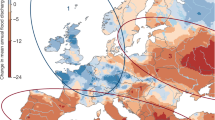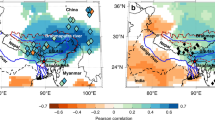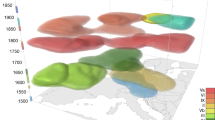Abstract
Megafloods that far exceed previously observed records often take citizens and experts by surprise, resulting in extremely severe damage and loss of life. Existing methods based on local and regional information rarely go beyond national borders and cannot predict these floods well because of limited data on megafloods, and because flood generation processes of extremes differ from those of smaller, more frequently observed events. Here we analyse river discharge observations from over 8,000 gauging stations across Europe and show that recent megafloods could have been anticipated from those previously observed in other places in Europe. Almost all observed megafloods (95.5%) fall within the envelope values estimated from previous floods in other similar places on the continent, implying that local surprises are not surprising at the continental scale. This holds also for older events, indicating that megafloods have not changed much in time relative to their spatial variability. The underlying concept of the study is that catchments with similar flood generation processes produce similar outliers. It is thus essential to transcend national boundaries and learn from other places across the continent to avoid surprises and save lives.
This is a preview of subscription content, access via your institution
Access options
Access Nature and 54 other Nature Portfolio journals
Get Nature+, our best-value online-access subscription
$29.99 / 30 days
cancel any time
Subscribe to this journal
Receive 12 print issues and online access
$259.00 per year
only $21.58 per issue
Buy this article
- Purchase on Springer Link
- Instant access to full article PDF
Prices may be subject to local taxes which are calculated during checkout




Similar content being viewed by others
Data availability
The flood discharge data from the data holders/sources listed in Extended Data Table 1 that were used in this paper are available at https://github.com/tuwhydro/megafloods.
Code availability
The data analysis was performed in R using the supporting packages circular, lubridate, plotrix, quantreg, raster, RColorBrewer, rgdal, rworldmap and scales. The code used can be downloaded from https://github.com/tuwhydro/megafloods.
References
Apel, H., Vorogushyn, S. & Merz, B. Brief communication: Impact forecasting could substantially improve the emergency management of deadly floods: case study July 2021 floods in Germany. Nat. Hazards Earth Syst. Sci. 22, 3005–3014 (2022).
Kreibich, H. et al. The challenge of unprecedented floods and droughts in risk management. Nature 608, 80–86 (2022).
De Niel, J., Demarée, G. & Willems, P. Weather typing based flood frequency analysis validated for exceptional historical events of past 500 years along the Meuse River. Water Resour. Res. 53, 8459–8474 (2017).
Robson, A. J. & Reed, D. W. Flood Estimation Handbook, Vol. 3 (Centre for Ecology & Hydrology, 1999).
Rogger, M. et al. Step changes in the flood frequency curve: process controls. Water Resour. Res. 48, W05544. (2012).
Bergstrand, M., Asp, S. & Lindström, G. Nationwide hydrological statistics for Sweden with high resolution using the hydrological model S-HYPE. Hydrol. Res. 45.3, 349–356 (2014).
Devitt, L., Neal, J., Wagener, T. & Coxon, G. Uncertainty in the extreme flood magnitude estimates of large-scale flood hazard models. Environ. Res. Lett. 16, 064013 (2021).
Bouaziz, L. et al. Behind the scenes of streamflow model performance. Hydrol. Earth Syst. Sci. 25, 1069–1095 (2021).
Kjeldsen, T. R. et al. Documentary evidence of past floods in Europe and their utility in flood frequency estimation. J. Hydrol. 517, 963–973 (2014).
Blöschl, G. et al. Current European flood-rich period exceptional compared with past 500 years. Nature 583, 560–566 (2020).
Ryberg, K. R., Kolars, K. A., Kiang, J. E. & Carr, M. L. Flood-Frequency Estimation for Very Low Annual Exceedance Probabilities Using Historical, Paleoflood, and Regional Information with Consideration of Nonstationarity (USGS, 2020).
WMO Atlas of Mortality and Economic Losses from Weather, Climate and Water Extremes (1970–2019) WMO-No. 1267 (WMO, 2021).
Blöschl, G., Nester, T., Komma, J., Parajka, J. & Perdigão, R. A. P. The June 2013 flood in the Upper Danube Basin, and comparisons with the 2002, 1954 and 1899 floods. Hydrol. Earth Syst. Sci. 17, 5197–5212 (2013).
Lionetti, M. The Italian floods of 4–6 November 1994. Weather 51, 18–27 (1996).
Herschy, R. W. The world’s maximum observed floods. Flow. Meas. Instrum. 13, 231–235 (2002).
Kuentz, A., Arheimer, B., Hundecha, Y. & Wagener, T. Understanding hydrologic variability across Europe through catchment classification. Hydrol. Earth Syst. Sci. 21, 2863–2879 (2017).
Lun, D. et al. Characteristics and process controls of statistical flood moments in Europe – a data-based analysis. Hydrol. Earth Syst. Sci. 25, 5535–5560 (2021).
Blöschl, G. Flood generation: process patterns from the raindrop to the ocean. Hydrol. Earth Syst. Sci. 26, 2469–2480 (2022).
Blöschl, G. Flood warning - on the value of local information. Int. J. River Basin Manag. 6, 41–50 (2008).
Blöschl, G. et al. Changing climate both increases and decreases European river floods. Nature 573, 108–111 (2019).
Bertola, M., Viglione, A., Lun, D., Hall, J. & Blöschl, G. Flood trends in Europe: are changes in small and big floods different? Hydrol. Earth Syst. Sci. 24, 1805–1822 (2020).
Blöschl, G. et al. Changing climate shifts timing of European floods. Science 357, 588–590 (2017).
Blöschl, G., Sivapalan, M., Wagener, T., Viglione, A. & Savenije, H. H. (eds) Runoff Prediction in Ungauged Basins: Synthesis across Processes, Places and Scales (Cambridge Univ. Press, 2013).
Kemter, M., Merz, B., Marwan, N., Vorogushyn, S. & Blöschl, G. Joint trends in flood magnitudes and spatial extents across Europe. Geophys. Res. Lett. 47, e2020GL087464 (2020).
Popescu, I., Jonoski, A., Van Andel, S. J., Onyari, E. & Moya Quiroga, V. G. Integrated modelling for flood risk mitigation in Romania: case study of the Timis–Bega River Basin. Int. J. River Basin Manag. 8, 269–280 (2010).
Collins, M. J., Hodgkins, G. A., Archfield, S. A. & Hirsch, R. M. The occurrence of large floods in the United States in the modern hydroclimate regime: seasonality, trends, and large-scale climate associations. Water Resour. Res. 58, e2021WR030480 (2022).
Donnelly, C., Andersson, J. C. M. & Arheimer, B. Using flow signatures and catchment similarities to evaluate a multi-basin model (E-HYPE) across Europe. Hydr. Sci. J. 61, 255–273 (2016).
Sivapalan, M. & Blöschl, G. Time scale interactions and the coevolution of humans and water. Water Resour. Res. 51, 6988–7022 (2015).
Merz, B., Vorogushyn, S., Lall, U., Viglione, A. & Blöschl, G. Charting unknown waters—On the role of surprise in flood risk assessment and management. Water Resour. Res. 51, 6399–6416 (2015).
Shepherd, T. G. Storyline approach to the construction of regional climate change information. Proc. R. Soc. A 475, 20190013 (2019).
Thieken, A. H., Samprogna Mohor, G., Kreibich, H. & Müller, M. Compound inland flood events: different pathways, different impacts and different coping options. Nat. Hazards Earth Syst. Sci. 22, 165–185 (2022).
Hall, J. et al. A European Flood Database: facilitating comprehensive flood research beyond administrative boundaries. Proc. Int. Assoc. Hydrol. Sci. 370, 89–95 (2015).
Roekaerts, M. The Biogeographical Regions Map of Europe. Basic Principles of its Creation and Overview of its Development (EEA, 2002).
Koenker, R. W. Quantile Regression (Cambridge Univ. Press, 2005).
Amponsah, W. et al. in Climate Change, Hazards and Adaptation Options (eds Leal Filho, W. et al.) 267–276 (Springer, 2020).
Tukey, J. W. Exploratory Data Analysis (Addison-Wesley, 1977).
Hubert, M. & Vandervieren, E. An adjusted boxplot for skewed distributions. Comput. Stat. Data Anal. 52, 5186–5201 (2008).
Brys, G., Hubert, M. & Struyf, A. A robust measure of skewness. J. Comput. Graph. Stat. 13, 996–1017 (2004).
Acknowledgements
We acknowledge all flood data providers listed in Extended Data Table 1. G.B. and M. Bertola were supported by the FWF projects ‘SPATE’ (I 3174, I 4776) and W1219-N22. B.M. and B.G. were supported by the DFG ‘SPATE’ project (FOR 2416). A.V., P.C., D.G., M. Borga and E.D. were supported by the European Union NextGenerationEU ‘RETURN’ Extended Partnership (National Recovery and Resilience Plan—NRRP, Mission 4, Component 2, Investment 1.3—D.D. 1243 2/8/2022, PE0000005). S.K. and J.S. were supported by the Slovak Research and Development Agency (number APVV-20-0374) and the VEGA Grant Agency (number 1/0782/21). J.H. and S.T. were supported by the ROBIN (Reference Observatory of Basins for INternational hydrological climate change detection) initiative, with funding from the Natural Environment Research Council (grant number NE/W004038/1). The authors acknowledge the involvement in the data screening process of M. Haas.
Author information
Authors and Affiliations
Contributions
G.B. and M. Bertola initiated the study and wrote the first draft of the paper. M. Bertola, G.B., M. Borga, A.C., P.C., E.D., D.G., A.M., A.V. and E.V. designed the study. M. Bertola collated the updated version of the database with the help of most of the co-authors and conducted the analyses. G.B. and M. Bertola interpreted the results in the context of underlying geophysical mechanisms. B.G., M. Boháč, A.C., S.K., O.L., S.L. M.M.-G., K.G., Z.G., B.G., J.K., B.M., P.M., J.P., L.P., I.R., K.S., J.S., P.V., P. Ward, P. Willems. and N.Ž. interpreted the results in Central Europe. G.T.A., O.B., M. Borga, A.C., I.Č., G.B.C., P.C., E.D., D.G., A.G., A.M., L.M., D.O., M.Š., A.V. and E.V. interpreted the results in Southern Europe. B.A., B.K., D.L. and N.V. interpreted the results in Northern Europe. J.H., S.H., C.M., S.T. and E.S. interpreted the results in Western Europe. I.D., N.F., L.G., M.K., J.K., M.O. and V.O. interpreted the results in Eastern Europe. All authors contributed to framing and revising the paper.
Corresponding author
Ethics declarations
Competing interests
The authors declare no competing interests.
Peer review
Peer review information
Nature Geoscience thanks the anonymous reviewers for their contribution to the peer review of this work. Primary Handling Editor: Tom Richardson, in collaboration with the Nature Geoscience team.
Additional information
Publisher’s note Springer Nature remains neutral with regard to jurisdictional claims in published maps and institutional affiliations.
Extended data
Extended Data Fig. 1 Map of the European study area.
Background colours indicate five European hydroclimatic regions. Open circles indicate the location of the 8,023 hydrometric stations analysed.
Extended Data Fig. 2 Sensitivity of results to the threshold distance Dmax.
(a) Number and (b) fraction of megafloods larger than envelope as a function of threshold distance; (c) average number of donor catchments as a function of threshold distance. Colours indicate the five hydroclimatic regions in Europe.
Extended Data Fig. 3 Sensitivity of results to the weights used for estimating distance D.
(a) Number and (b) fraction of megafloods larger than envelope for four weight combinations: equal weights (‘equal’, α = β = γ = 1), double weight for Area (‘wA’, α = 2), double weight for mean annual flood (‘wQm’, β = 2), double weight for CV (‘wCV’, γ = 2). (c) Average number of donor catchments for the four weight combinations. Colours indicate the five hydroclimatic regions in Europe.
Extended Data Fig. 4 Megafloods in Europe for alternative hydroclimatic regions.
(a) Five alternative hydroclimatic regions17. (b–f) Maximum observed specific flood discharges (points) and mean of annual specific flood discharges (squares) over the entire observation period at each stream gauge as a function of catchment area. Regional envelope curves (thick lines) and median regional annual specific flood discharges (thin lines) are shown for each hydroclimatic region.
Extended Data Fig. 5 Sensitivity of results to the threshold distance Dmax.
(a) Number and (b) fraction of megafloods larger than envelope as a function of threshold distance; (c) average number of donor catchments as a function of threshold distance. Colours indicate the five alternative regions of Extended Data Fig. 4a.
Extended Data Fig. 6 Sensitivity of results to the weights used for estimating distance D.
(a) Number and (b) fraction of megafloods larger than envelope for four weight combinations: equal weights (‘equal’, α = β = γ = 1), double weight for Area (‘wA’, α = 2), double weight for mean annual flood (‘wQm’, β = 2), double weight for CV (‘wCV’, γ = 2). (c) Average number of donor catchments for the four weight combinations. Colours indicate the five alternative regions of Extended Data Fig. 4a.
Extended Data Fig. 7 Predicted versus observed megafloods.
Similar to Fig. 4 but for the five alternative regions of Extended Data Fig. 4a. a, Predicted specific envelope discharge for 498 target catchments versus observed specific discharge of the megafloods in the same catchments. Predicted envelope discharges are estimated using discharge observations from a pool of donor catchments up to the year before the target megaflood. Colours indicate the ratio of observed and predicted discharge. b, Location of target catchments. Megafloods occur all over Europe and are less surprising than commonly assumed. c, Circular distribution of the timing of the megafloods observed in the target catchments (black lines), and mean timing of the ten largest floods in the donor catchments (coloured points) and their distribution (brown lines). The distance of the points to the centre is inversely proportional to the standard deviation of the flood timing. N-E, North-Eastern; C-E, Central-Eastern; MED, Mediterranean; ALP, Alpine; ATL, Atlantic.
Supplementary information
Supplementary Information
Supplementary Figs. 1–3.
Rights and permissions
Springer Nature or its licensor (e.g. a society or other partner) holds exclusive rights to this article under a publishing agreement with the author(s) or other rightsholder(s); author self-archiving of the accepted manuscript version of this article is solely governed by the terms of such publishing agreement and applicable law.
About this article
Cite this article
Bertola, M., Blöschl, G., Bohac, M. et al. Megafloods in Europe can be anticipated from observations in hydrologically similar catchments. Nat. Geosci. 16, 982–988 (2023). https://doi.org/10.1038/s41561-023-01300-5
Received:
Accepted:
Published:
Issue Date:
DOI: https://doi.org/10.1038/s41561-023-01300-5



